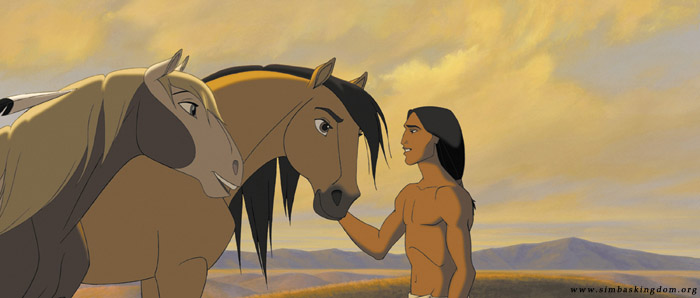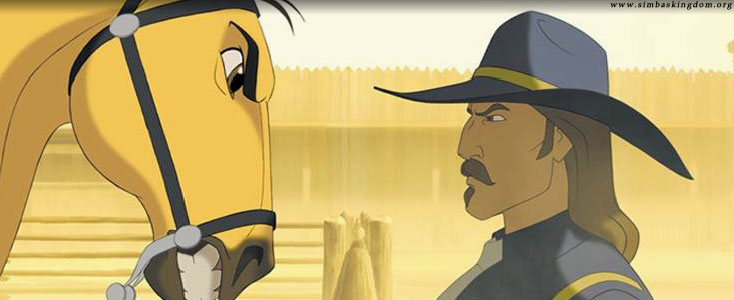 An expanded version of my Indian Comics Irregular essay Spirit and the Noble Savage:
An expanded version of my Indian Comics Irregular essay Spirit and the Noble Savage: An expanded version of my Indian Comics Irregular essay Spirit and the Noble Savage:
An expanded version of my Indian Comics Irregular essay Spirit and the Noble Savage:
DreamWorks' new movie, Spirit: Stallion of the Cimarron, has a Native American backdrop. Spirit is a feisty mustang of the Old West who is "born free" and grows up to lead the Cimarron herd. Critic Kenneth Turan continues (LA Times, 5/24/02):
What also comes with maturity are encounters with unpleasant white men, intent on subjugating the West in general and Spirit in particular. They're epitomized by the Colonel (James Cromwell), who serves as bondage master during Spirit's brief stay with the cavalry. If the white people cause every bit of the trouble in this film, the Native Americans, living as it happens in perfect harmony with the natural world, are just as schematically presented as uniformly virtuous. This is especially true of the young Lakota brave Little Creek (Daniel Studi), who hooks up with Spirit and happens to possess a fetching paint mare named Rain that catches Spirit's eye.
Or as Chris Kaltenbach of the Baltimore Sun puts it:
Cross Walt Disney with John Ford and you'd get "Spirit: Stallion of the Cimarron." Except those two master filmmakers would come up with a far more engaging film than this gorgeous, but otherwise nondescript, horse opera.
"Spirit" is awash in wonder, from Matt Damon's narration to the unwavering nobility of Little Creek and his Native American brothers and sisters. It's a vision of the West that Hollywood has embraced ever since "Dances With Wolves"—a wondrous place until Western Civilization came and did its dirty work.
Not that there's anything wrong with that particular message; man befouling nature has been a theme of animated movies ever since audiences started sobbing at the death of Bambi's mother. But "Spirit" doesn't move that idea along much and lacks the memorable imagery that turns a film into a classic.

A correspondent adds her opinion:
I saw "Spirit" over the weekend. It was kind of silly. Sort of "Dances With Wolves" meets "The Horse Whisperer."
Little Creek was very likable, but too good to be true. Naturally, he talked to animals. The Lakota village looked like a Thomas Kinkade painting.
No matter how well the movie does it, making the Indians Lakota is the first stereotype. Hello? Are any white people aware there were (and are) at least a dozen Plains tribes? Choosing the Lakota every time is little different from making every Indian a brave with a bow and arrow, a tipi, and a chief.
If you look at just the visuals, the message is clear. A half-naked Indian youth contrasts with a fully-outfitted Army officer. It's a classic: the innocent noble savage vs. the corrupt civilized man.
Anything wrong with that? Well, yes. I've argued before that a positive stereotype is still a stereotype. It creates lofty expectations that no real people can meet.
Painting Indians as paragons of virtue only sets them up for a fall. Your typical non-Indian is apt to say, "Look, they're building casinos. They don't care about their land or culture. They're in it for the money just like us.
"We don't have to give them 'special rights.' We don't have to honor the treaties we signed. They're just pretending to live in harmony with the world."
As I always say, a positive stereotype is better than a negative stereotype, but reality is best.
Another review of Spirit (5/28/02)
From John Peloquin (Metis):
I saw Spirit. It was relatively unobjectionable with some minor criticisms on my part. The movie gets big points from me for not having talking animals—other than the narrative from the point of view of Spirit the horse. I HATE talking animals a la Disney cartoons like Bambi. However the horses were anthropomorphic which I dislike. The indian fellow was identified by name once right away when he came on screen. I remembered that his name was, IMHO, reasonable, or at least not stupid, though I don't remember the exact name. He was supposed to be Lakota. I don't know much about Lakota culture so I don't know how Lakota trained their horses. I would hope they talked to some traditional Lakota about how to portray everyone. The characters, Indian and white were all portrayed as human beings in a surprizingly complex manner for a cartoon. The bad guys weren't entirely evil and the good guys were not perfect, though the native characters came pretty close to perfect, as of course we are ;-) . The raid on the Indian camp was correctly portrayed as unprovoked, but the "battle" was cleaned up for kiddy consumption. I was a little disturbed in that the main Indian character was referred to as a boy, but then he probably was a boy. However, I didn't remember any adult Indian characters, as they weren't developed much, though since the story was about the horse and his Native friend, I guess that's acceptable. On the whole, I thought it was a cute movie on the whole and not particularly offensive.
Rob's comment
The boy's name was Little Creek. On the one hand, it wasn't your typical bear/wolf/eagle name. On the other hand, the "little" moniker reinforces the idea that the boy is a child rather than a man. That he's meek or weak or underdeveloped compared to an adult.
Suppose the creators had named the boy "Big Creek" instead of "Little Creek." This is perfectly plausible, since the adjective refers to the size of the creek, not the size of the boy. What would this name tell us?
To me it would cause some cognitive dissonance. Big Creek sounds like a strong, tough, independent character. I expect him to take on anyone, up to and including an Army colonel, without assistance.
In my mind, Big Creek is an accomplished warrior. He doesn't need a horse to make him complete. Little Creek does.
The boy has a "little" moniker for the same reason Little Tree does. For the same reason so many Indian women have names like Little Flower or Little Moon. The diminutive name diminishes them.
The lack of adult Natives leads to the same result. It diminishes the richness and complexity of Indian life. It conveys the idea that Indians were scarce in the area—i.e., in the process of vanishing. That white men were the norm and Indians were the exception. In reality, it was the other way around.
Related links
Romanticized Indians
Uncivilized Indians
|
. . . |

|
All material © copyright its original owners, except where noted.
Original text and pictures © copyright 2007 by Robert Schmidt.
Copyrighted material is posted under the Fair Use provision of the Copyright Act,
which allows copying for nonprofit educational uses including criticism and commentary.
Comments sent to the publisher become the property of Blue Corn Comics
and may be used in other postings without permission.